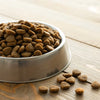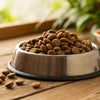Can Dry Dog Food Sit in a Hot Car? Understanding the Risks for Our Furry Friends
- Houndsy
Table of Contents
- Introduction
- The Science Behind Dog Food Spoilage
- How Long Can Dog Food Stay in a Hot Car?
- Practical Tips for Pet Owners
- The Role of Houndsy in Enhancing Your Dog Feeding Experience
- Conclusion
- FAQ Section
Introduction
Picture this: it’s a warm, sunny day, and you’ve decided to take your furry friend on a little outing. You pack their favorite dry kibble, excited for a fun day together. But just as you hop out of the car to run an errand, you realize you’ve left their food sitting in the sweltering heat. This situation leads us to a critical question: can dry dog food sit in a hot car?
As pet owners, we want to ensure our dogs receive the best nutrition possible, and understanding how temperature affects dog food is crucial for their health. Surprisingly, a staggering 60% of pet owners are unaware of the risks associated with storing dog food in hot environments. In this blog post, we will explore the important factors surrounding the question of how long dog food can safely remain in a hot car.
By the end of this article, you will be equipped with the knowledge to protect your dog’s meals from heat-related spoilage and make informed decisions about their nutrition, especially during warmer months. Let’s embark on this journey together, reflecting on our own pet care practices and discovering how to keep our beloved companions healthy and happy.
The Science Behind Dog Food Spoilage
To understand the risks involved with leaving dog food in a hot car, it’s essential to first comprehend what dog food consists of. Most dry kibble is formulated with proteins, fats, carbohydrates, vitamins, and minerals, all of which play vital roles in your dog’s overall health. However, exposure to heat can significantly alter the nutritional integrity of these ingredients.
Key Components of Dog Food
- Proteins: Essential for growth, repair, and overall well-being.
- Fats: Provide energy but can become rancid when exposed to high temperatures.
- Carbohydrates: Offer quick energy and aid digestion.
- Vitamins and Minerals: Critical for various bodily functions, including immunity and bone health.
How Heat Affects Nutritional Quality
- Fat Spoilage: High temperatures can accelerate the oxidation of fats, leading to rancidity. Rancid fats not only lose nutritional value but can also cause digestive issues for your dog.
- Loss of Vitamins: Essential vitamins—particularly A, D, E, and K—are sensitive to heat. Prolonged exposure may diminish their effectiveness, risking deficiencies in your dog's diet.
- Changes in Texture and Smell: Heat can alter the physical properties of dog food, making it less palatable. Changes in smell, texture, or appearance can deter dogs from eating.
The Role of Humidity
Humidity, when paired with heat, creates a dangerous environment for dog food. High humidity can lead to:
- Mold Growth: Moisture can cause mold to develop on kibble, posing serious health risks if ingested.
- Insect Infestation: Humid conditions attract pests that can infest dog food, further compromising its safety.
How Long Can Dog Food Stay in a Hot Car?
When considering how long dry dog food can remain in a hot car, several factors come into play, including the temperature outside, the type of dog food, and the duration of exposure. Here’s a breakdown:
- Under 80°F (27°C): Dry kibble can typically stay safe for up to 24 hours if kept in a sealed container. However, always check for any changes in smell or appearance.
- Between 80°F and 90°F (27°C to 32°C): Limit exposure to no more than 4 hours to prevent potential spoilage.
- Above 90°F (32°C): It’s strongly advised to avoid leaving any dog food in the car for more than 1-2 hours. The risk of rancidity and spoilage increases significantly.
Signs of Spoilage
If you suspect that your dog’s food may have been compromised, look for the following signs:
- Odor: A rancid smell is a clear indicator that the food has gone bad.
- Texture Changes: If the kibble feels oily or sticky, it may have absorbed moisture and spoiled.
- Visual Changes: Look for discoloration or any signs of mold, which signal that the food is unsafe.
Practical Tips for Pet Owners
To protect your dog’s food from the heat, consider these practical storage tips:
Use Quality Containers
Invest in airtight containers designed for pet food. This helps keep moisture and air out, prolonging freshness. Our Houndsy Kibble Dispenser is an excellent option, featuring a BPA-free liner that keeps food fresh while also adding a stylish touch to your home.
Avoid Leaving Food in the Car
If you need to transport dog food, always take it with you when you exit the vehicle. If you anticipate being away from the car for an extended period, consider bringing along a cooler to keep the food safe.
Monitor Temperature
If possible, use a thermometer to monitor the temperature inside your car. Vehicles can heat up quickly, especially in the summer months.
Regular Check-Ins
If you’re on a road trip, plan regular stops to assess the state of your dog’s food. This ensures you're aware of any changes that might indicate spoilage.
Observe Your Dog's Eating Habits
Pay attention to your dog’s eating habits. If they suddenly refuse to eat or show signs of digestive upset, it may be time to reassess the quality of their food.
The Role of Houndsy in Enhancing Your Dog Feeding Experience
At Houndsy, we understand the importance of a reliable feeding solution that caters to the health and happiness of your furry companions. Our flagship product, the Houndsy Kibble Dispenser, embodies our commitment to combining innovative design with functionality.
Key Features of the Houndsy Kibble Dispenser
- Elevated Design: Our dispenser features a convenient crank at standing height, eliminating the need for bending, making feeding easier for you.
- Perfect Portion Control: Each serving dispenses the right amount, ensuring your dog receives consistent nutrition every time.
- Quality Materials: We use high-quality, BPA-free materials to keep your dog's food fresh and safe.
- Sleek Aesthetic: With a mid-century modern design, it seamlessly integrates into your home decor while enhancing your dog’s feeding experience.
By investing in the Houndsy Kibble Dispenser, you not only simplify your dog's feeding routine but also ensure their meals remain fresh and nutritious.
Conclusion
Understanding how long dry dog food can safely sit in a hot car is crucial for every pet owner. The combination of heat and humidity can lead to spoilage, negatively impacting your dog's health. By following best practices for storage and being vigilant about the signs of spoilage, you can ensure that your furry friend enjoys fresh and nutritious meals.
As we strive to provide the best for our dogs, let’s simplify and enhance their feeding routines with products that align with our values of convenience, design excellence, and pet well-being. Explore our Houndsy Kibble Dispenser today and elevate your dog’s feeding experience by visiting our product page here.
FAQ Section
Can I leave my dog food in the car overnight?
Leaving dog food in the car overnight, especially in warm weather, is strongly discouraged. The risk of spoilage increases significantly, and it’s best to store it in a cool, dry place.
How can I tell if my dog food has gone bad?
Look for changes in smell, color, and texture. A rancid smell, discoloration, or an oily texture are signs that the food may be spoiled.
What should I do if my dog refuses to eat their food?
If your dog shows disinterest in their food or exhibits signs of digestive discomfort after eating, it may be a sign that the food has spoiled. Always check the quality of the food before offering it.
How should I store dog food during the summer months?
Store dog food in an airtight container in a cool, dry location. Avoid exposing it to direct sunlight or heat sources.
What are the risks of feeding my dog spoiled food?
Feeding spoiled food can lead to digestive upset, vomiting, diarrhea, and long-term health issues. Always prioritize your dog's safety by ensuring their food is fresh and safe to consume.













